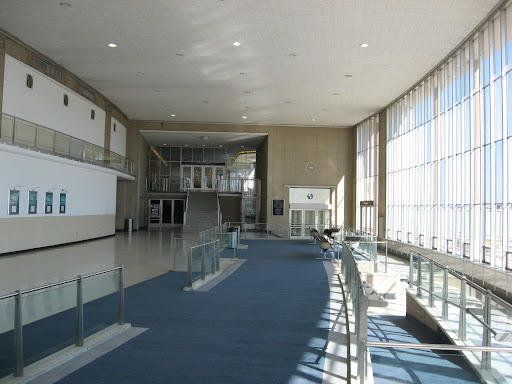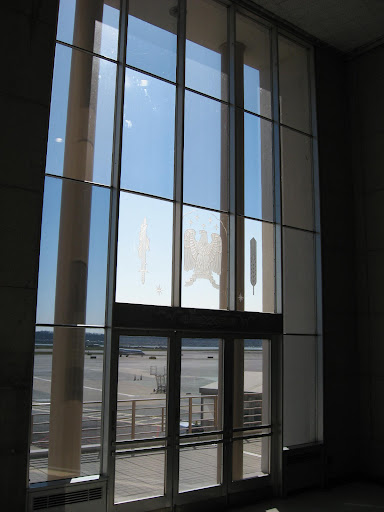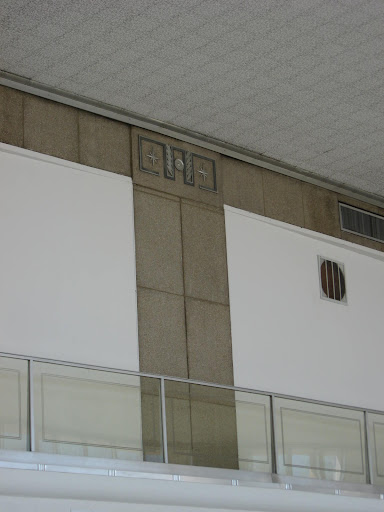The other day I wasn't in Japan (although my brother-in-law was - he flew all the way to Tokyo from Boston for the Red Sox' opener), but I was in the old main terminal hall at (Ronald Reagan) National Airport.

The Main Terminal hall (now called Terminal A) is open, following lengthy renovation, but isn't being used. It's just "on the way" between the parking garage and the new terminals where all the flights are.
It has a lot of history, though. It was completed in 1940, as part of the New Deal airport construction that produced many glorious Art Deco edifices, including La Guardia, and the now-demolished Tampa Airport terminal at Peter O. Knight field.

Here's a close up of the plaque:

National, like most of the other terminals, was built by the Works Progress Administration, who were serious about their Art Deco. Although I am no Rooseveltian Socialist, I'm all in favor of government bureaucrasy that is serious about Art Deco.
Here's some more:

That photo doesn't do the architecture justice...

By the way - for those who are following the subject: the presentation about Juan Trippe's globe has been rescheduled from April 9 to April 30. This is bad for me because I'm afraid I'll miss it. It is only a 15 minute event, however, so I think I'm going to go down to the Smithsonian sometime in the next week and check out the new exhibit, and maybe try to talk to the Conservatrix Of The Globe personally.

7 comments:
I love Art Deco. Unlike some of the crap from the 50's, 60's and 70's, it's architecture that looked to the future and has held up over time.
You're not going to be there in late April? Dang. By the time you posted, the date had already changed, and that's when I could be there. I had assumed late April was what you meant.
Heading East again in a few days.
I've got to go back South for the last week of April, unfortunately. I should be back in DC sometime in May, however - no exact date yet.
In simple words this website is great, all information is very useful. On a TV, are pixels changeable?
Press the Settings or Menu button on your remote. The screen of your TV will show a menu. Look for the Resolution or Output Resolution option. Additionally, you might find it in the Display, Setup, Aspect Ratio, Zoom Mode, or Picture Mode menus. Read this article to know Dead pixels.
The Social Security Disability Program provides long-term protection to individuals who are totally disabled, consistent with Social Security criteria. It is meant to provide benefits only to those individuals with the most serious impairments. Browse this page to learn more about the program and how to apply for benefits.
here - social security disability benefits
For TrilioVault to work correctly and to backup your PersistentVolumeClaim (PVCs), the Kubernetes cluster needs to be configured to support the Container Storage Interface (CSI). By default, the DigitalOcean Managed Kubernetes Service comes with the CSI driver already installed and configured. You can check this using the following command.
know more here - kubernetes cluster backup and restore
If you cannot write a supportive letter of recommendation (e.g., if you did not work with the
student very long or did not have a good experience), please let the student know that he/she should
request a letter from someone else.
The tips below assume that you are in support of the student’s application and would like to see
him/her be successful:
The strongest letters include at least 3 paragraphs:
o Introduction – including how long and in what capacity you have known the student
o 2nd Paragraph – outlining details of your assessment of the student’s abilities
o Conclusion – summarizing the strength of your recommendation
Letter length is often interpreted as a measure of the strength of your recommendation – if your
recommendation is strong, the letter should go on to a second page; letters that are 1 page or
less are often considered “red flags” by some program directors
Include accurate descriptions and specific examples of the student’s abilities – avoid either
exaggeration or overly vague/generic descriptors
When possible, include statistics (e.g., “Ms. Jones is among the top 5% of students with whom I
have worked,” or 10%, 20%, etc.)
In describing any weaknesses, consider whether you can frame them positively (e.g.,
“demonstrated improvement in documentation…” rather than “demonstrated poor
documentation”)
Include any position titles, including faculty appointments, in your signature
“Real” signatures are preferred over digital signatures
Post a Comment